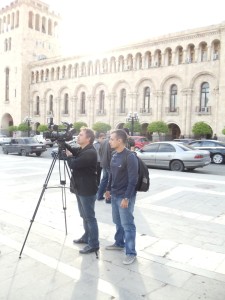Interview by Karin Saghdejian
Bared Maronian specializes in producing Armenian documentaries, with three films produced so far. Women of 1915 is his documentary which unveils the role of the Armenian women of the era and the horrors they endured during the Armenian Genocide. The film follows his highly acclaimed documentary, Orphans of the Genocide, on the plight of the Armenian Genocide orphans. Here’s our interview with him.
Q- Your film Women of 1915 is being widely acclaimed as did your previous production Orphans of Genocide. Why did you decide to make a “Genocide sequel”?
A-About 6 years ago, while conducting preliminary research on Orphans of Genocide, I kept on stumbling into amazing stories of women who, one way or another, were linked to the Genocide.
It wasn’t one, two or a few stories… while hundreds of thousands of Armenian women were victimized, hundreds, perhaps thousands of non-Armenian- Scandinavian, American, European, Canadian and Australian – women flocked onto the killing fields of the Armenian Genocide and rescued tens of thousands of Armenian women and children.
This, I thought, was the ultimate humanitarian task. Leaving a plush life behind, traveling thousands of miles to war zones, risking your life to save the lives of strangers. In some cases these women lost their lives while saving the lives of others. I thought that was an unparalleled self sacrifice. I couldn’t help, but dedicate a whole film to this topic. Thus, Women of 1915.
Q- You don’t call the documentary Women of Genocide and that’s for a reason I guess. Who are these women whom you wanted to document?
A-I named the film Women of 1915 and not Women of Genocide in an effort to delineate the universality of the Armenian Genocide. Even though the Armenian Genocide was brought upon the Armenians by the [Ottoman] Turks, the horrific and heroic experiences of the Armenian women were of human survival, human triumph, human resilience in times of war. Armenian women were raped, enslaved, dehumanized by their Turkish perpetrators with an attempt to strip them from their identity by forcibly changing their names, religion, language, culture and even appearance. Despite all that, the Armenian woman became the inevitable founders of the post-genocide Armenian societies in the diaspora.
Q- Can you recall some names and what types of role they played? What about the numbers of all those who perished?
A-The film is narrated by the character of Maria Jacobsen, a Danish nurse who dedicated her life to the rescue of the victims of the Armenian Genocide. Jacobsen’s experience with the Armenians was a linear one. She was in Western Armenia during the Hamidian Massacres, experienced the brunt of the Genocide with the Armenians and eventually died and was buried at the Armenian orphanage, the Birds Nest in Lebanon, while tending to Armenian orphans.
Another woman of 1915 is the American Mary Louise Graffam, a trained teacher, dedicated her life to educating students and teachers in Western Armenia and died in Sivas in 1921.
We also feature a number of Armenian women of 1915, such as Diana Apcar, the first woman ambassador in modern history, Victoria Artinian, Steve Job’s adoptive grandmother, Hatun Yapoujian, who bore arms and fiercely fought to protect her people and of course the typical women of 1915, such as Aurora Mardiganian, who’s story was turned into a block buster Hollywood movie in 1919, just to name a few…
Q- The topic requires extensive and may be unprecedented research. How do you conduct your research and what type of sources did you tap into?
A-Our research is a combination of primary and secondary research. For example, even though there is ample information on Aurora Mardiganian, we travelled all the way to Argentina to interview Eduardo Kozanlian, who accidently discovered the remnants of Aurora Mardiganian’s movie, Auction of Souls or Ravished Armenia.
On then other hand, after exhausted research we were able to connect with Steve Jobs grandmother’s family and were able to find a trunk full of documentation on Job’s grandmother.
Q- Do you have another addition to this series? What’s the next project you might be working on?
A-My third Genocide related film is in the works and deals with an extremely interesting story remotely connected to the Hamidian Massacres.





